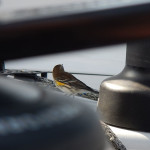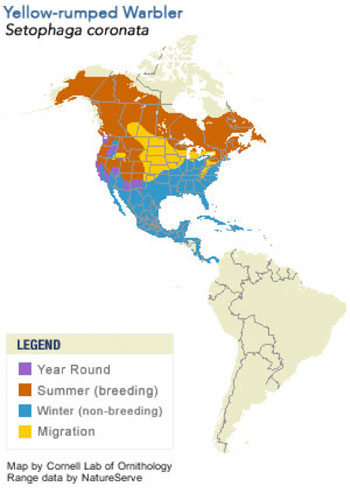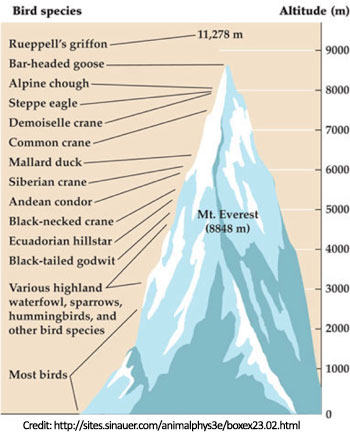So, while I’m out here at … oh, let’s see … 32.74017W, 0.61875N, getting pretty close to the equator … and still spending a lot of time dealing with the unruly elements, it seemed like a good time to introduce you to Tegan Mortimer. Tegan is an ocean scientist with Earthwatch who you might remember from the Boston Harbor whale watch videos. Tegan is helping us on the expedition on several levels.
- Curating our Citizen Science Resources page
- Advising us on our Explorer Guides (working to get them up there soon!)
- Fielding my questions and helping with identification of wildlife sightings
- Posting those wildlife sightings to a cool site named iNaturalist.org
- Receiving and recording all the research data that we gather
Thank you Tegan, it’s great to have you along for the trip!
 Now, if you recall, when I was 200 miles off the coast of New Jersey, a bird landed on the boat. Tegan helped us to identify it as a yellow-rumped warbler. The whole issue of bird migrations struck a spark and we asked Tegan to tell us more about bird migrations – because after all it is that time of year. This then is the first of her series of “Science Notes” … and I think you’ll find it worth your while to follow along … and especially good to share with the young’uns.. Take it away, Tegan!
Now, if you recall, when I was 200 miles off the coast of New Jersey, a bird landed on the boat. Tegan helped us to identify it as a yellow-rumped warbler. The whole issue of bird migrations struck a spark and we asked Tegan to tell us more about bird migrations – because after all it is that time of year. This then is the first of her series of “Science Notes” … and I think you’ll find it worth your while to follow along … and especially good to share with the young’uns.. Take it away, Tegan!
:: TEGAN’S SCIENCE NOTES: #1 – BIRD MIGRATIONS
A songbird over 200 miles from land? That seems like an unusual sighting! How could a little bird get that far from land? Did it get caught in a storm? It’s certainly true that birds can get blown off course and end up in strange places; this is usually followed by storms of excited bird watchers camped out in the hopes of catching a glimpse of a rare sighting!
Dave’s visit from a Yellow-Rumped Warbler on his way to Bermuda was probably not one of these lost birds. If you read my response in a recent post, then that you know that this tiny songbird is probably migrating; heading south to the Caribbean Islands to spend the winter while food in its northern summer home is hard to find.
 Some yellow-rumped warblers fly farther than others; the maximum distance is about 2,500 miles from right up at the top of the tundra down to the Caribbean, but that’s really nothing compared to species that fly 8,000 to 12,000 miles in a single migration.
Some yellow-rumped warblers fly farther than others; the maximum distance is about 2,500 miles from right up at the top of the tundra down to the Caribbean, but that’s really nothing compared to species that fly 8,000 to 12,000 miles in a single migration.
Some yellow-rumped warblers, like those that summer here in New England might only go as far south as the Carolinas, but those that spend the summer farther north tend to go much farther south. Still other varieties can survive a cold winter where other species of warbler would just starve. This is because they have a secret weapon! They are some warblers which are able to digest the waxes found in wax-myrtle berries and bayberries, thus providing themselves a wintertime food source without needing to fly as far south as other warbler species.
 Every fall millions of birds ranging in size from small warblers like Bodacious Dream’s visitor, to shorebirds and hawks fly to the Caribbean, Central America and South America to wait out the winter. These huge flocks of migrating birds often go unnoticed because they fly very high up in the air and often fly at night. Flocks of songbirds crossing stretches of water, like the Gulf of Mexico, usually fly around 10,000 feet up, but they have been recorded flying twice as high as that! Migrating birds have even been identified by passenger jets at cruising altitude. An amazing example is the bar-headed goose which migrates over the highest mountains in the world, the Himalayas, at heights of 29,500 feet. Even more amazing is that these geese fly over the mountains in a single day!
Every fall millions of birds ranging in size from small warblers like Bodacious Dream’s visitor, to shorebirds and hawks fly to the Caribbean, Central America and South America to wait out the winter. These huge flocks of migrating birds often go unnoticed because they fly very high up in the air and often fly at night. Flocks of songbirds crossing stretches of water, like the Gulf of Mexico, usually fly around 10,000 feet up, but they have been recorded flying twice as high as that! Migrating birds have even been identified by passenger jets at cruising altitude. An amazing example is the bar-headed goose which migrates over the highest mountains in the world, the Himalayas, at heights of 29,500 feet. Even more amazing is that these geese fly over the mountains in a single day!
So how do these birds find their way, especially if they’re flying over the water? It was thought for a very long time that migrating birds flew at night so that they could use the stars for navigation, but then researchers realized that these birds are still able to navigate on cloudy nights. How exactly they navigate over such long distances is still a mystery, but scientists think that they may use many different senses to navigate including using the stars. Pigeons have been proven to be able to use their sense of smell to navigate and birds contain small amounts of the mineral Magnetite which is thought to help them sense the earth’s magnetic fields and see polarized light which can all help to navigate.
Animals that migrate are of special conservation concern because they travel so far and often traverse many countries with different laws. A species that is protected in one country may be hunted heavily in another. Luckily, the yellow-rumped warbler and many other migratory birds are protected by a treaty between the United States and other countries which protects these birds and their habitats as collective natural heritage. Additionally, the yellow-rumped warbler is widespread and has a large population so for conservation purposes it is considered to be of “least concern.” This species is not expected to face extinction any time in the near future. However that does not mean that climate change, habitat destruction, and human impacts won’t have effects on it which could possibly lead to declines or even extinction.
Earthwatch scientists are studying migratory songbirds that nest in the Rocky Mountains. Over the past 5 years these researchers and Earthwatch volunteers have seen a trend which indicates that many of these common and widespread songbirds are less successful nesting closer to human development. Human development is pushing further and further into “wild” land in some parts of the world, what could this mean for even our most common animals and birds?
Birds might be the most remarkable migrators, but they are hardly the only animals that Dave will see mid-migration. Can you think of some other ocean animals that migrate? Where are they going and why are they going there?
(Tegan Mortimer is a scientist with Earthwatch Institute. Contact Tegan directly at Tegan Mortimer <tmortimer (at) earthwatch (dot) org>)
